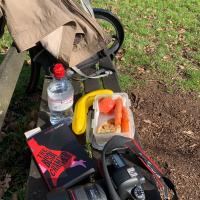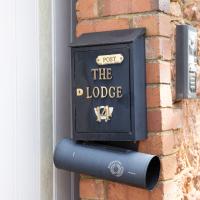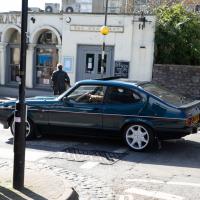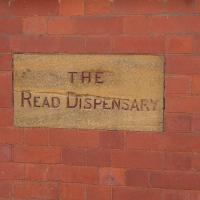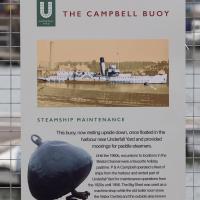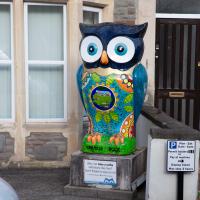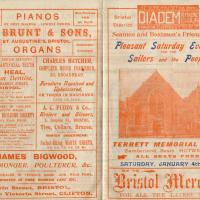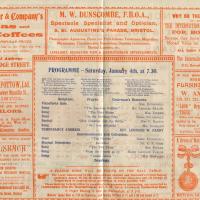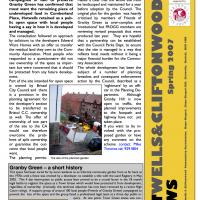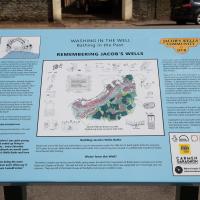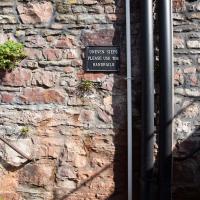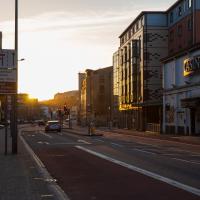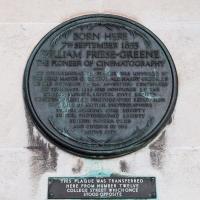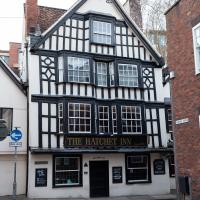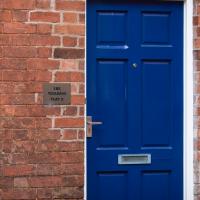Tagged: the
A Day Off Wander in Clifton
26 Feb 2021
I'm on the first day of a long weekend, and I certainly picked the right one for it. This may be the first proper spring-like day of the year in Bristol; it was glorious.
I headed up to Clifton, around the area where I got my Covid vaccine jab the other day, to knock off a few remaining roads in that area and because it would be good exercise for an extended lunchtime walk.
Along the way I saw some very Clifton sights, including an Aston Martin, some Jacobethan architecture, and some private college sports grounds. Mostly, though, I just enjoyed the sunshine, and took every opportunity I could to snap views across the city.
A little glimpse behind the scenes. Salmon and broccoli quiche, apple, banana, carrots, thanks for asking.
Tags: Bristol Places UK onemilematt united kingdom Clifton
Auto-Tags: Bottle Tire Luggage and bags Plant Water bottle Grass Bag Motor vehicle Gas Lawn Recreation Plastic bottle Soil Automotive tire Personal protective equipment
Text Recognition Tags: v CAT THE BIRDY v CAT THE BIRDY
I'm glad my friend Lisa joined me today; she drove in from Shirehampton and told me that the Portway was looking rather lovely, so we set off that way. She's also braver than I am when it comes to doing urbex stuff, so this was just the opportunity to take a peek into the Portnalls Number One Railway Tunnel/Bridge Road Deep Valley Shelter whose entrance I'd found on a previous wander.
It was definitely dark and spooky and impressively big, with a side tunnel that Lisa explored that leads to a little door I don't think I've previously noticed on the side of the Portway. I didn't get many photos—even my astoundingly powerful little torch (£) didn't do much to light things up, and you're not going to get much joy hand-holding a camera in that darkness—but I did shoot a little video, which I might edit and add later.
After plumbing the bowels of the earth, we went up Bridge Valley Path to Clifton, explored some bits around the College and Pembroke Road, then came home via Foliage Cafe for coffee. Nice.
Don't see those around much.
Tags: Bristol Places UK onemilematt united kingdom Clifton
Auto-Tags: Rectangle Brickwork Fixture Brick Building material Font Gas Composite material Signage Number Address sign Metal Sign Mortar Public utility
Text Recognition Tags: POST THE D LODGE POST THE D LODGE
Somewhat blurry pic of a 2.8 Capri. Couldn't resist. I think I've snapped this in this area before.
Tags: Bristol Places UK onemilematt united kingdom Clifton Village Clifton
Auto-Tags: Tire Wheel Car Automotive parking light Land vehicle Vehicle Window Vehicle registration plate Infrastructure Motor vehicle Automotive design Alloy wheel Plant Building Personal luxury car
Text Recognition Tags: BUYASTAR THANK THE DRANT TRE CUA NHS Briste ZZA BUYASTAR THANK THE DRANT TRE CUA NHS Briste ZZA
Harbour Circumnavigation
01 Mar 2021
Normally I don't have enough time in my lunch hour to get all the way around the harbourside. This is a shame, as Wapping Wharf is a great place to get coffee and a snack, but it's pretty much diametrically (perimetrically?) opposite me on the harbour. Today I had the day off, so I decided to go and knock off a few streets around Anchor Road that I'd not covered, as well as visiting the site of the Read Dispensary (well, one of them) and dropping into Mokoko for one of their astounding almond croissants. From there I came back along the south side, checking out the views from as much of the Chocolate Path as you can venture down at the moment, and swapping from Cumberland Road to Coronation Road at Vauxhall Bridge.
There's a lot of meh photos on this walk—my chief output from this project could be politely described as "record shots"—but a few turned out well, especially those of Vauxhall Bridge from the Chocolate Path, which reminded me how much of a loss the current closure of the Chocolate Path is to walkers and cyclists in Bristol.
This is why I'm here. Yesterday I processed this picture from a Clifton wander some time back, which is a plaque to Eliza Walker Dunbar, who founded the Read Dispensary. According to Weird Bristol it was founded in 1874 and moved to this St George’s Road location in 1907. (Wikipedia seems to think the Read Dispensary was founded in 1876, but her obit in the BMJ seems to confirm 1874.)
It was founded by Dunbar and a Miss Read, hence the name, along with "other supporters of the independence of women".
Tags: Bristol Places UK onemilematt united kingdom St George's Road Oryx Executive Search Read Dispensary
Auto-Tags: Brown Building Brick Rectangle Brickwork Building material Wood Font Composite material Symmetry Mortar Signage Pattern Bricklayer Circle
Text Recognition Tags: THE READ DISPENSARY THE READ DISPENSARY
Of Bridges and Buoys
04 Mar 2021
A trip to Imagine That coffee, so no fresh roads knocked off my list, but I stopped off to snap a couple of the engineering-related bits of the docks: the Campbell Buoy (used by P&A Campbell for mooring their paddle steamers) and Brunel's "other" bridge, the foot/horse swing bridge that now sits sadly disused in the shadow of the Plimsoll Bridge at Howard's Lock.
Tags: Bristol Places UK onemilematt united kingdom harbourside floating harbour harbour Spike Island engineering Buoy Campbell Buoy docks
Auto-Tags: Airship Blimp Vertebrate Aircraft Aerostat Motor vehicle Vehicle Aviation Zeppelin Air travel Font Gas Advertising Aerospace engineering Design
Text Recognition Tags: THE CAMPBELL BUOY STEAMSHIP MAINTENANCE This buoy, now resting upside down, once floated in the harbour near Underfal Yard and provided moorings for paddle steamers. Lrtil the 1980s, eounions to locations in the Brietol Channel werea tavourte hokday pastime. P&A Campbel operated a fleet of ships trom the hartbour and rented part of Udertal Yard for maintenance operations from the 1320s unti 1956. The Big Shed was used as a machine shop while the old boler room inow the Visitor Centrej and the outsicle are krown as the Knuckle wore ned as a foundry. THE CAMPBELL BUOY STEAMSHIP MAINTENANCE This buoy, now resting upside down, once floated in the harbour near Underfal Yard and provided moorings for paddle steamers. Lrtil the 1980s, eounions to locations in the Brietol Channel werea tavourte hokday pastime. P&A Campbel operated a fleet of ships trom the hartbour and rented part of Udertal Yard for maintenance operations from the 1320s unti 1956. The Big Shed was used as a machine shop while the old boler room inow the Visitor Centrej and the outsicle are krown as the Knuckle wore ned as a foundry.
I headed to Bedminster to do a crossword with my support bubble today. On the way I delved into a couple of bits of Hotwells history, first of all snapping a "now" shot to go with a historical photo of Holy Trinity I happened across recently, and second of all to snap the Britannia Buildings.
The Britannia Buildings are a little strip of offices on a corner of the Hotwell Road. They've mostly been the headquarters of a cleaning company for years, but I've often wondered what this distinctive curve of offices, its ground floor standing proudly out from the upper floors, used to be. Well, after my last wander, where I poked about the landing stage just down the road, I found out! Researching the paddleboat company P&A Campbell I came across this nugget in The A-Z of Curious Bristol, by Maurice Fells (£):
The firm of P & A Campbell was the main steamer operator in the Bristol Channel, with its local headquarters in offices close to the Hotwells pier and overlooking the harbour at the Cumberland Basin. Campbell's named their offices Britannia Buildings, after one of the ships in their White Funnel Fleet.
So! Turns out the Britannia Buildings were named after a paddle steamer—you can see some pictures of Britannia here.
In related news, I've now bought three of Maurice Fells' local history books, and they were hand-delivered by the author on Sunday, a half-hour after I ordered them online (through a message exchange on Nextdoor!) Not even Amazon Prime has managed to deliver me anything that quickly...
"I'd like to buy an owl, please."
"We don't sell owls."
"Someone told me you did."
"Who?"
"See! I just heard one!"
Tags: Bristol Places UK onemilematt united kingdom Bedminster owl Local Pages Boris
Auto-Tags: Vertebrate Window Mammal Art Bird Graffiti Wall Automotive lighting Owl Painting Gas Great horned owl Font Vehicle registration plate Snapshot
Text Recognition Tags: 00 Men Sat Permit halders Pay at reachine Display ticket Wy ettake a she with os the Od Dent fonget o tagusin Hax stay 3 houra 00 Men Sat Permit halders Pay at reachine Display ticket Wy ettake a she with os the Od Dent fonget o tagusin Hax stay 3 houra
Since setting up a search for Hotwells on eBay I've mostly managed to restrain myself from buying much (or in one case, was outbid, luckily for my finances.) However, I couldn't resist a 1902 flyer for a singalong at the Terrett Memorial Hall, which would have stood five minutes' walk from my flat, overlooking Howard's Lock.
I've found out a fair bit about this non-denominational seaman's mission, including tracking down both a Loxton drawing and an aerial photo of it. The main thing that's eluded me, ironically enough, is finding out who Terrett was, so as a Memorial Hall it didn't do a very good job 😀.
EDIT: Ah! Did a little more digging and found that the Bristol Archives has a Bristol Dock Company document on file called "William Terrett, Esq.; corresp. etc. re proposed erection of a Mission Hall at Cumberland Basin, 1892", so that might be worth a look once the Archives are properly open again. Given that:
Sarah Terrett died suddenly on 25 November 1889, aged 53, after speaking at a meeting of the White Ribbon Army, the temperance organization she had founded in 1878. Following her death many people sent letters of sympathy to her bereaved husband, William. One of these, from the Rev. W. F. James, a minister of the Bible Christians, makes for especially interesting reading. The Bible Christian denomination, to which Sarah and William belonged, was one of the smaller Methodist connexions, and had its heartland in rural Devon, the area where she had grown up. James recalled the hospitality he enjoyed when visiting the Terretts’ home, Church House, in Bedminster, south Bristol...
...I wonder if William Terrett built the hall in memory of his late wife. They were clearly just the kind of temperance movement people who would've founded a seaman's mission to get people together to have a nice non-alcoholic singsong rather than a night out on the tiles.
Anyway. This walk to grab a coffee from Hopper Coffee in Greville Smyth Park was mostly an excuse to post the leaflet, a few other things I found related to it, and some pictures of how the site looks now. I would suggest that the present day is not an improvement.
This was my random eBay purchase. I had no idea that the Terrett Memorial Hall had ever existed until I saw this leaflet up for sale.
There's some information on the hall on the Places of Worship database; as you can guess from the title of the leaflet it was basically a seaman's mission, with the aim "to promote the social, moral and religious welfare of sailors and provide sleeping accomodation for seamen, also free beds for destitute seafarers"
My favourite random thing on this leaflet is probably that the Surgeon Dentist is called Mr Heal.
Tags: Bristol Places UK onemilematt united kingdom Hotwells Cumberland Basin Flyover System Cumberland Piazza Cumberland Basin Terrett Memorial Hall
Auto-Tags: Font Material property Publication Brickwork Paper Book Pattern Paper product Brick History Newsprint Book cover Rectangle Holy places Document
Text Recognition Tags: BE SURE YOU CET THE ROYAL F RASNC DIADEM UR Hire Parebane PIANOS As to ATSS. Bristol of the per Month. BY BEST MAKERS LUWEST PRICS FRACTICAL TEST PRIVES THL BESTIneorponated Seamen and Boatmen's Friend Society. District W. BRUNT & SONS, ST. AUGUSTINE'S, BRISTOL. Pleasant Saturday Evenings Instreinenta Instrunents ORGANS Repatred. Exthanged roR THE Sailors and the People. ANERICAN A ENOISH DENTITRY Prize Medal ARTIFICIAL TEETH. Mr. HEAL, Surgeon Dentist, CHARLES HATCHER, COMPLETE HOUSE FURNISHER, 20, BROADMEAD. 25, OLD MAHKEr STREET. BRISTOL. Furnituro Repaired and Upholstered, the t quaty OR TAKEN IN EXCHANGE. CASIL OR IHIRK. a An Metais C Monik s pmaro WET oF NGLANO AND SOUTH WALES A. C. PUDDY & Co. PRRMANENT BUILDING SOCIETY Hosiers and Glovers, SL Staphan's ureat, Bristat he sosh ANNUAL REPORT 3. Dolphie St., BRISTOL Ties, Collars, Braces, Re Men t i anora frebeYBARS Ma FOR DORIDWER AY TER WINTER UNDERWEAR. Parfect-fitting WHITE SHIRTS, in a . e e TERRETT MEMORIAL HALL, Cumberland Basin. HOTWELLS A dm, A Ere JAMES BIGWOOD, ALL SEATS PREE. FISHMONGER, POULTERER, &c. SATURDAY, JANUARY 4th, 1902. BUY THE Bristol Mercury LICENSED DEALER IN VENISON, GAME AND WILD FOWL IMPORTER oF PURE WENHAM LAKE IOE. Baldwin Street, BRISTOS, and Victoria Street, CLIFTON. FOR ALL THE LATEST NEWS. BE SURE YOU CET THE ROYAL F RASNC DIADEM UR Hire Parebane PIANOS As to ATSS. Bristol of the per Month. BY BEST MAKERS LUWEST PRICS FRACTICAL TEST PRIVES THL BESTIneorponated Seamen and Boatmen's Friend Society. District W. BRUNT & SONS, ST. AUGUSTINE'S, BRISTOL. Pleasant Saturday Evenings Instreinenta Instrunents ORGANS Repatred. Exthanged roR THE Sailors and the People. ANERICAN A ENOISH DENTITRY Prize Medal ARTIFICIAL TEETH. Mr. HEAL, Surgeon Dentist, CHARLES HATCHER, COMPLETE HOUSE FURNISHER, 20, BROADMEAD. 25, OLD MAHKEr STREET. BRISTOL. Furnituro Repaired and Upholstered, the t quaty OR TAKEN IN EXCHANGE. CASIL OR IHIRK. a An Metais C Monik s pmaro WET oF NGLANO AND SOUTH WALES A. C. PUDDY & Co. PRRMANENT BUILDING SOCIETY Hosiers and Glovers, SL Staphan's ureat, Bristat he sosh ANNUAL REPORT 3. Dolphie St., BRISTOL Ties, Collars, Braces, Re Men t i anora frebeYBARS Ma FOR DORIDWER AY TER WINTER UNDERWEAR. Parfect-fitting WHITE SHIRTS, in a . e e TERRETT MEMORIAL HALL, Cumberland Basin. HOTWELLS A dm, A Ere JAMES BIGWOOD, ALL SEATS PREE. FISHMONGER, POULTERER, &c. SATURDAY, JANUARY 4th, 1902. BUY THE Bristol Mercury LICENSED DEALER IN VENISON, GAME AND WILD FOWL IMPORTER oF PURE WENHAM LAKE IOE. Baldwin Street, BRISTOS, and Victoria Street, CLIFTON. FOR ALL THE LATEST NEWS.
I find the adverts fascinating. My first optician in Bristol was Dunscombe's on St Augustine's Parade, so they were there a long time. They've closed now (or at least moved) but were still there as recently as 2008, I think. Interesting to see gas lighting systems being advertised, too!
Tags: Bristol Places UK onemilematt united kingdom Hotwells Cumberland Basin Flyover System Cumberland Piazza Cumberland Basin Terrett Memorial Hall
Auto-Tags: Newspaper Font Paper Menu Document Paper product Publication
Text Recognition Tags: M. W. DUNSCOMBE, F.B.0.A.,e d WHY DO THE PEOPLE Spectaele Specielist and Optician, 5, St. AUGUSTINE'S PARADE, BRISTOL. Barber &Company's Teas and THE INTERNATIONAL BOOT CO FOR B0OTS? Coffees Photograplie Apparatus, Opes snd Field Glae Telescopen, Magniticn Microscopes Theenameters. Barometers, Drawing lostruments. Optial Laterns, ete. LIMELIGHT, DISSOLVING VIEW A CINEMATOGRAPH ENTERTAINMENTS. Because they know they will get Honest Value tor their money. AT POPULAR PRICES. ONE MUSDED TEAB ALL GASH PIORS. The International Boot Co., Bristol Addreas 33, BRIDGE STREET. 2a, Hetvell Rd., BRISTOL. PROGRAMME – Saturday, Januaty 4th, at 7.30. Estalilahed 1834. IF YOU WANT SHIRTING COLE&POTTOW,Ltd. 15 to 18, Lower Maudlin St., FLANNELETTE, W. AXTENS, 219. 221, 223, Hlotwell Road. LION Brand at 6 d. "TIGER" eter ne range. 2 Tia. ialld by a. Derpasd y NOSE, Astcar THY ৰ । Des t BRISTOL Seripture. Pianoforte Solo. Prayer. Chairman's Remarks. READY-MADE AND BESPOKE TAILORS. Mi FireucoaIL Mr LoA TATLO The Amoec daktal "The HoBhrine" In the thening Grey *How llortlue ie Beidge "Oh! kliheful" Song Song at 5{d. Miss TuK Sti Porata Mis F. Hanter Duet Largast Stock of Ready-Made Clothing in the Wet ol Eagland. Scamen's Complete Ourfits. Recital Song TEMPERANCE ADDRESS M lowan REV. LEONARD W. PARRY ELANNELK, BLANKETS. QUILS, Duet Musinal Selootions Song Song Song Annoaneoments and Colleetion. The aina Acdion "The Te Cities" When the ande g by "Antie anrie Doxology. Mis Fo LI Mr. E IL Do A Gross of Watches for London PREPAUE TO THE MINTER SEASON "WELSBACH Mis Tter Mater LaA TAXton EVELLERT, INCANESCENT GAN LIT SSTEM emar te RELABACE KERN BUN ngecres el er ot- the A PLEDGE BOOK WILL BE FOUND ON THE HALL TABLE. The Lacal Cemmitta t the lntorpated seamen and Boatmes's Friend foclety arnestly appeal te the Mambers t the Chrlatlan Chuncho nd all frienda of Temperince te ugpot thee goteria in every passible way. Thone dentring te help, ether In providinprgremme or canvaalng, e requostad to communicate with the Supertetendent, ke EW, Parry, Avenhurat, Cumhertand Road A Preper Mastin held a Wednerday, at8 pm. Hithe lacl iur il T10 Tarslays, and aday Teeat 11 a 30t ioel r Ant WILSACE HARTRA Muity e Riches i Apply fir paminla te Welsbech Inndescent Gas Light Co, A Titoria Strest, Bristal WATTS & C Ld., p Stokes Croft. M. W. DUNSCOMBE, F.B.0.A.,e d WHY DO THE PEOPLE Spectaele Specielist and Optician, 5, St. AUGUSTINE'S PARADE, BRISTOL. Barber &Company's Teas and THE INTERNATIONAL BOOT CO FOR B0OTS? Coffees Photograplie Apparatus, Opes snd Field Glae Telescopen, Magniticn Microscopes Theenameters. Barometers, Drawing lostruments. Optial Laterns, ete. LIMELIGHT, DISSOLVING VIEW A CINEMATOGRAPH ENTERTAINMENTS. Because they know they will get Honest Value tor their money. AT POPULAR PRICES. ONE MUSDED TEAB ALL GASH PIORS. The International Boot Co., Bristol Addreas 33, BRIDGE STREET. 2a, Hetvell Rd., BRISTOL. PROGRAMME – Saturday, Januaty 4th, at 7.30. Estalilahed 1834. IF YOU WANT SHIRTING COLE&POTTOW,Ltd. 15 to 18, Lower Maudlin St., FLANNELETTE, W. AXTENS, 219. 221, 223, Hlotwell Road. LION Brand at 6 d. "TIGER" eter ne range. 2 Tia. ialld by a. Derpasd y NOSE, Astcar THY ৰ । Des t BRISTOL Seripture. Pianoforte Solo. Prayer. Chairman's Remarks. READY-MADE AND BESPOKE TAILORS. Mi FireucoaIL Mr LoA TATLO The Amoec daktal "The HoBhrine" In the thening Grey *How llortlue ie Beidge "Oh! kliheful" Song Song at 5{d. Miss TuK Sti Porata Mis F. Hanter Duet Largast Stock of Ready-Made Clothing in the Wet ol Eagland. Scamen's Complete Ourfits. Recital Song TEMPERANCE ADDRESS M lowan REV. LEONARD W. PARRY ELANNELK, BLANKETS. QUILS, Duet Musinal Selootions Song Song Song Annoaneoments and Colleetion. The aina Acdion "The Te Cities" When the ande g by "Antie anrie Doxology. Mis Fo LI Mr. E IL Do A Gross of Watches for London PREPAUE TO THE MINTER SEASON "WELSBACH Mis Tter Mater LaA TAXton EVELLERT, INCANESCENT GAN LIT SSTEM emar te RELABACE KERN BUN ngecres el er ot- the A PLEDGE BOOK WILL BE FOUND ON THE HALL TABLE. The Lacal Cemmitta t the lntorpated seamen and Boatmes's Friend foclety arnestly appeal te the Mambers t the Chrlatlan Chuncho nd all frienda of Temperince te ugpot thee goteria in every passible way. Thone dentring te help, ether In providinprgremme or canvaalng, e requostad to communicate with the Supertetendent, ke EW, Parry, Avenhurat, Cumhertand Road A Preper Mastin held a Wednerday, at8 pm. Hithe lacl iur il T10 Tarslays, and aday Teeat 11 a 30t ioel r Ant WILSACE HARTRA Muity e Riches i Apply fir paminla te Welsbech Inndescent Gas Light Co, A Titoria Strest, Bristal WATTS & C Ld., p Stokes Croft.
One Albermarle Row, Granby Green and... People
12 Mar 2021
I was browsing some historical photos the other day, and came across "Rear of Unspecified House" in the Bristol Archives' John Trelawny Ross collection, and immediately recognised it as being the back of 1 Albermarle Row, just around the corner from me. I've not had much time to research the history of this odd little addition to Albermarle Row, or what happened to 1-4 Cumberland Place, number 4 of which used to be attached to the side of 1 Albermarle Row, but it was interesting to look at old maps for a few minutes and work out what used to be where.
That all connects with the little local bit of land at Granby Green, too, as it used to be numbers 1-3 Cumberland Place. There was something of a planning battle over Granby Green, and I've included an old edition of Hotwells & Cliftonwood News that I found online, a copy of which would have been popped through my letterbox at the time.
I was also inspired by some old pictures of Hotwell Road to try to put a few more people in my pictures, though I set my pre-focus a couple of extra metres out from normal to make sure I didn't get too close to anyone!
Tags: Bristol Places UK onemilematt united kingdom Hotwells Cumberland Place Granby Green
Auto-Tags: Tire Automotive tire Newspaper Publication Motor vehicle Tread Font Wheel Material property News Vehicle Automotive wheel system Advertising Tire care Screenshot
Text Recognition Tags: Decision time for new h&cca Open Space in Hotwells HOTWELLS & CLIFTONWOOD COMMUNITY ASSOCIATION A recent poll of the people who sion granted to Edward Ware Homes campaigned in vain to preserve makes it clear that the whole site must Granby Green has confirmed that be landscaped and maintained for a year most want the remaining piece of before adoption by the Council, The undeveloped land in Cumberland original plan for the garden was heavily Place, Hotwells retained as a pub- criticised by members of Friends of lic open space with local people Granby Green as over-complex and having a say in how it is developed 'institutional but FROGG members are reviewing revised proposals that were The consultation followed an approach produced last year. They are hopeful by solicitors to the developers Edward that a partnership can be established with the Council Parks Dept. to ensure the residual land they own to the Com that the site is managed in a way that munity Association. Most people who reflects local needs without it being a responded to a questionnaire did not major financial burden for the Commu- ed by and managed. Ware Homes with an offer to transfer see ownership of the space as impor- nity Association. tant but were concermed that it should The whole development has been the be protected from any future develop- subject of a number of planning breaches and consequent enforcement Part of the site intended for open space action by the Council, described as a 'nightmare by an offi- cer in the Planning De- Alkhough Granby Hill is now open to traffic, the planned improvements to the footpath and highway have not yet ment. is owned by Bristol City Council and there is a provision in the planning agreement for the developer's section to be transferred to partment. Bristol C.C. owmership as well. The offer of ownership of one part of the site to the CA taken place. If you want to be in- volved with the pro- posed garden or have any comment on the scheme contact Mike would not therefore overcome the prob lems of split ownership or guarantee the out- come that local people Timmins tel: 9291804 want. The planning permis- The s of the panned garden Granby Green -a short history This apace had cared for by local residents a an informal community garden from as far back as the 1970s unail a fance was erected by a develaper, to establiah a tde with the Land Ragistry in May 2002 Tha 4 day interruption to pubic access later proved to be a crudal factor in the IB legal battle to regster the space as Town Green which would have protected it from developmere, n renoved by a recent High pnenas of Graby Green) campagned to Ibeen regardiess of ownership (iroricaly. chis technical objection has now been Court rulng A support group of around 100 local people prevent the loss of the space and the group tced a professional legal team at a three day publik in In this edition: Community News Winning ideas - Meet Your Neighbour -6 Events & Activities - quiry At one point, Town Green satus wos con ferred by the Bristol CC Open Spaces committee but bear rescinded folawing thrests of legal action by the then ownieri, Etward Ware Homes. Local resident Mike Timmin has ggeed that the now smaler space below Walace Place, che new 4 block of Mats should be christened Gromit Gar. 7 dens Rey Smth Contacts 8 HOTWELLS&CLIFTONWOe Spring 2007 SM3N Published y Hetwells A CIenweed Cemmunity Aassetaten, Htepe Chapel, Hepe Chapel Hill, Hetwells, Brtatel. BSa 4ND Decision time for new h&cca Open Space in Hotwells HOTWELLS & CLIFTONWOOD COMMUNITY ASSOCIATION A recent poll of the people who sion granted to Edward Ware Homes campaigned in vain to preserve makes it clear that the whole site must Granby Green has confirmed that be landscaped and maintained for a year most want the remaining piece of before adoption by the Council, The undeveloped land in Cumberland original plan for the garden was heavily Place, Hotwells retained as a pub- criticised by members of Friends of lic open space with local people Granby Green as over-complex and having a say in how it is developed 'institutional but FROGG members are reviewing revised proposals that were The consultation followed an approach produced last year. They are hopeful by solicitors to the developers Edward that a partnership can be established with the Council Parks Dept. to ensure the residual land they own to the Com that the site is managed in a way that munity Association. Most people who reflects local needs without it being a responded to a questionnaire did not major financial burden for the Commu- ed by and managed. Ware Homes with an offer to transfer see ownership of the space as impor- nity Association. tant but were concermed that it should The whole development has been the be protected from any future develop- subject of a number of planning breaches and consequent enforcement Part of the site intended for open space action by the Council, described as a 'nightmare by an offi- cer in the Planning De- Alkhough Granby Hill is now open to traffic, the planned improvements to the footpath and highway have not yet ment. is owned by Bristol City Council and there is a provision in the planning agreement for the developer's section to be transferred to partment. Bristol C.C. owmership as well. The offer of ownership of one part of the site to the CA taken place. If you want to be in- volved with the pro- posed garden or have any comment on the scheme contact Mike would not therefore overcome the prob lems of split ownership or guarantee the out- come that local people Timmins tel: 9291804 want. The planning permis- The s of the panned garden Granby Green -a short history This apace had cared for by local residents a an informal community garden from as far back as the 1970s unail a fance was erected by a develaper, to establiah a tde with the Land Ragistry in May 2002 Tha 4 day interruption to pubic access later proved to be a crudal factor in the IB legal battle to regster the space as Town Green which would have protected it from developmere, n renoved by a recent High pnenas of Graby Green) campagned to Ibeen regardiess of ownership (iroricaly. chis technical objection has now been Court rulng A support group of around 100 local people prevent the loss of the space and the group tced a professional legal team at a three day publik in In this edition: Community News Winning ideas - Meet Your Neighbour -6 Events & Activities - quiry At one point, Town Green satus wos con ferred by the Bristol CC Open Spaces committee but bear rescinded folawing thrests of legal action by the then ownieri, Etward Ware Homes. Local resident Mike Timmin has ggeed that the now smaler space below Walace Place, che new 4 block of Mats should be christened Gromit Gar. 7 dens Rey Smth Contacts 8 HOTWELLS&CLIFTONWOe Spring 2007 SM3N Published y Hetwells A CIenweed Cemmunity Aassetaten, Htepe Chapel, Hepe Chapel Hill, Hetwells, Brtatel. BSa 4ND
John Carr's Terrace
16 Mar 2021
I wanted a nice simple lunch-hour walk that took me past a cafe today, and I managed to find the perfect road to knock off my list of targets to do it. Situated just off Jacobs Wells Road, right next to Queen Elizabeth's Hospital, John Carr's Terrace, and Rosebery terrace above it, which I'd completely forgotten existed, are a little cul-de-sac that many Bristolians will have wandered past a thousand times without ever seeing.
There's a reason it's next to QEH:
Known traditionally as "The City School", Queen Elizabeth's Hospital was founded by the will of affluent merchant John Carr in 1586, gaining its first royal charter in 1590.
John Carr's terrace itself isn't much to write home about, architecturally, but I like the secluded feel of it, and I really liked Rosebery Terrace with its little houses, commanding position and friendly, slightly tumbledown feel.
On the way home I popped into Foliage Cafe for a coffee and a very pleasant nutella and banana pastry, then walked home past the refurbishment of the old Thali Cafe into a new and interesting clinic...
Now the well house seems to have stopped overflowing and the sign board is no longer cordoned off, it's time for a closer look. Lots of good info here.
Tags: Bristol Places UK onemilematt united kingdom Jacob's Well
Auto-Tags: Plant community Ecoregion Vertebrate Map World Green Nature Leaf Natural environment Botany Grass Biome Font Public space Line
Text Recognition Tags: WASHING IN THE WELL Bathing in the Past JACOB'S WELLS COMMUNITY HUB REMEMBERING JACOB'S WELLS Building Jacob's Wes Beths Commat foundahion Viah home whem wa gal yeung abour 17, and ended op iing in warios bedat y Setureley egular a cockwork we t co do ecob Wel ath an hae v tadng a lt u ee v A wlem ar w lwte ite FERRY Water from the Wel? CARMEN GARAGHON Eremenber then beg the est anaing baihe dten sy i they wee s ould come T ie a the Theat Cmpe dy ot W p DeentChaer 2theer Ho iteat My-iacle koal leming C WASHING IN THE WELL Bathing in the Past JACOB'S WELLS COMMUNITY HUB REMEMBERING JACOB'S WELLS Building Jacob's Wes Beths Commat foundahion Viah home whem wa gal yeung abour 17, and ended op iing in warios bedat y Setureley egular a cockwork we t co do ecob Wel ath an hae v tadng a lt u ee v A wlem ar w lwte ite FERRY Water from the Wel? CARMEN GARAGHON Eremenber then beg the est anaing baihe dten sy i they wee s ould come T ie a the Theat Cmpe dy ot W p DeentChaer 2theer Ho iteat My-iacle koal leming C
Tags: Bristol Places UK onemilematt united kingdom Jacob's Well
Auto-Tags: Plant Wood Brick Brickwork Building material Rectangle Facade Road surface Groundcover Landscape Font City Stone wall Road Rock
Text Recognition Tags: UNEVEN STEPS PLEASE USE THE HANDRAILS UNEVEN STEPS PLEASE USE THE HANDRAILS
Harbourside Milestone
17 Mar 2021
The other day I realised (hello, Maggie!) that my next walk would be my hundredth, and that I'd done 393.4km so far. I figured it would be nice to get to 100 walks and 400km on the same walk, so I went for a nice long harbourside wander after work, rather than dashing out at lunchtime. As it turned out, we're just coming up to the time of year where I can leave the house at 5:30 in the evening and there's still just enough light to take photos by the time I've made it around the harbourside. Though only just, and mostly because I've got a full-frame camera that's not bad in low light...
Still, the evening light made a lovely change, and some of the photos turned out to be pretty good photos per se, rather than just record shots of my walk. I'm looking forward to more evening walks like this as summer approaches.
On the way around this evening I wandered through one of the oldest bits of the city to extend my walk and snapped some interesting bits of architecture, including an NCP car park(!) and a nighttime shot of one of my favourite subjects, the clock tower at the Albion dockyard.
Tags: Bristol Places UK onemilematt united kingdom harbourside floating harbour harbour
Auto-Tags: Sky Daytime Building Window Infrastructure Road surface Asphalt Architecture Dusk Sunlight Neighbourhood Vehicle Residential area Morning Cloud
Text Recognition Tags: CASINO (Millennium Suvare Endescooy Cha Watarsbad Ww The Cuneu Bristol itu CASINO (Millennium Suvare Endescooy Cha Watarsbad Ww The Cuneu Bristol itu
From Wikipedia:
William Friese-Greene (born William Edward Green, 7 September 1855 – 5 May 1921) was a prolific English inventor and professional photographer. He is principally known as a pioneer in the field of motion pictures, having devised a series of cameras in 1888–1891, with which he shot moving pictures in London. He went on to patent an early two-colour filming process in 1905. His inventions in the field of printing – including photo-typesetting and a method of printing without ink – brought him wealth, as did his chain of photographic studios. However, he spent everything he earned on inventing, went bankrupt three times and was jailed once, before dying in poverty.
This year there's apparently a year-long celebration of his life and work.
Tags: Bristol Places UK onemilematt united kingdom plaque harbourside floating harbour harbour William Friese-Greene cinematography photographer
Auto-Tags: Font Gas Commemorative plaque Circle Public utility Art History Electric blue Memorial Concrete Signage Symmetry Number
Text Recognition Tags: BORN HERE SEPTEMBER 1855 VILLIAM FRIESE-GREENE E PLONBER OF CINEMATOGRAPHY UORD MAYOR O SRISTOL, ALE KAIRIRY C R L 7 ER 195 AND HONOURES BY THE STO GEE, BEISTO eivte sucIETy UTE OF RITISH PROOGRAPHERS RISIO AB GUR CnC SOITY BRISEOL CBRA CLUB NETIVI CITY THIS PLAQUE WAS TRANSFERRED HERE FROM NUMBER TWELVE COLLEGE STREET WHICH ONCE STOOD OPPOSITE BORN HERE SEPTEMBER 1855 VILLIAM FRIESE-GREENE E PLONBER OF CINEMATOGRAPHY UORD MAYOR O SRISTOL, ALE KAIRIRY C R L 7 ER 195 AND HONOURES BY THE STO GEE, BEISTO eivte sucIETy UTE OF RITISH PROOGRAPHERS RISIO AB GUR CnC SOITY BRISEOL CBRA CLUB NETIVI CITY THIS PLAQUE WAS TRANSFERRED HERE FROM NUMBER TWELVE COLLEGE STREET WHICH ONCE STOOD OPPOSITE
It's a bit wonky, but then so would you be if you'd been there since 1606.
Tags: Bristol Places UK onemilematt united kingdom harbourside floating harbour harbour The Hatchet
Auto-Tags: Sky Window Building Wood Neighbourhood Tree Door Residential area Facade City House Urban design Mixed-use Road Apartment
Text Recognition Tags: THE HATCHET INN Oe er THE HATCHET INN Oe er
Quick Around-the-Harbour Wander with Lisa
20 Mar 2021
My friend Lisa was meeting another friend for a walk near the suspension bridge, so we fitted in a quick harbourside loop from my place first. We discussed gardening (we're both envious of the gardening skills of the Pooles Wharf residents; we can just about keep herbs alive, whereas they're growing heartily-fruiting lemon trees outdoors in England along with everything from bonsai to magnolias), cafes, work and architecture, among other things.
Tags: Bristol Places UK onemilematt united kingdom Hotwells Grenville Chapel Grenville Methodist Chapel
Auto-Tags: Door Fixture Blue Wood Lighting Brick Handle Building Home door Building material Brickwork Line Rectangle Material property Facade
Text Recognition Tags: THE VICARADE TLATE THE VICARADE TLATE
